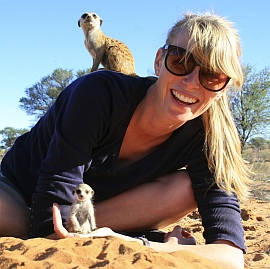Today’s Interview with an Author is with Dr. Alecia Carter, the first author on “Personality predicts the propensity for social learning in a wild primate” which we published today. If you are interested in asking Dr Carter (or one of her co-authors, Dr Marshall) anything about their research, then they are online all day today, answering your questions.

Dr. Carter is a Junior Research Fellow at Churchill College, University of Cambridge. She is interested in animal personalities, and she is exploring the influence of personality in the use of social and personal information for decision-making.
PJ: Can you tell us about Baboon personality and the research you published today?
AC: Animals use information to make decisions about all aspects of their lives. Despite the importance of information use in understanding how animals make decisions, little is known about how individuals may differ in how they use information. In the research that we publish today, we attempted to understand whether personality can explain some of the individual differences in the use of social information in wild baboons.
We found that baboons use social information to learn about novel foraging tasks and whether they used this information depended on their personality. Though we predicted that shy individuals would learn from bold individuals about the tasks, our prediction was not supported by the data: bold (and anxious) baboons learnt. This finding is not really what it seems: the bold baboons were not necessarily cleverer than the shy baboons; they were just bold enough to interact with the tasks. The shy individuals probably had the social information necessary to solve the task, they just didn’t use it. This is important for studies that wish to understand individual differences in cognition: If an animal doesn’t solve a cognitive task, how will a researcher know that an animal can’t or just won’t because of its personality?
PJ: What challenges did you face while doing this research?

AC: Testing the baboons with the stimuli! Working on free-ranging, completely autonomous wild animals is very tricky and quite nerve racking at times. The experiments required a lot of patience; I often had to wait for hours for the target baboon to be sitting next to a demonstrator baboon only to have another baboon come along and ‘ruin’ the situation. I also had to make sure that the baboons did not see me presenting them with the tasks, as they can become quite aggressive over food. I have become quite practiced at being nonchalant around baboons; I’m not sure it’s a transferable skill!
PJ: What kinds of lessons do you hope the public and the scientific community take away from the research?
AC: Don’t judge a baboon by its performance in a cognitive task! Like in all research projects, we faced a few hurdles when completing this research that have made us ask new questions about how social information flows through a social network. Baboon social networks are based on short and long-term friendships, as in human social networks. Our findings from this study have made us consider: Do all individuals have equal access to social information, or do some rely more on personal information? Does an individual’s social network preclude it from accessing some sources of social information? If so, which networks matter for access to information?
PJ: How did you first hear about PeerJ, and what persuaded you to submit to us?
AC: I heard about PeerJ through a friend who knows I believe the future of academic publishing lies in transparency. I really liked PeerJ’s model for open access and open peer review and wanted to support the idea by publishing here.
PJ: Was there anything that surprised you with your overall experience with us?
AC: I was surprised by how incredibly fast both the review and the publication processes were, and how helpful and enthusiastic everyone on the PeerJ team have been.
PJ: Given your experience, what would an ideal publishing venue look like?
AC: An ideal publishing venue for me would be not-for-profit open access; it would have alt-metrics for articles instead of an impact factor for the journal; it would have post-publication, open peer review for which contributors (reviewers) could get recognition for the hours of work it takes to complete a good review; it would have post-publication commenting and discussion; and the submitted work would be judged on its scientific soundness, not on its perceived novelty, ‘sexiness’ or popularity.
PJ: What do you think about our “Pay once, Publish for life” publishing plans?
AC: It’s an amazing idea, especially for researchers (like us) who wish to support open access journals, but don’t necessarily have the funding to cover some of the exorbitant fees other journals require.
PJ: Thanks very much!
Experience the PeerJ process for yourself, and take advantage of our free publication offer (when you also submit a preprint) through the last day of March.
(Photo Credits: Miquel Torrents (top) and Katie Hatton (bottom))
